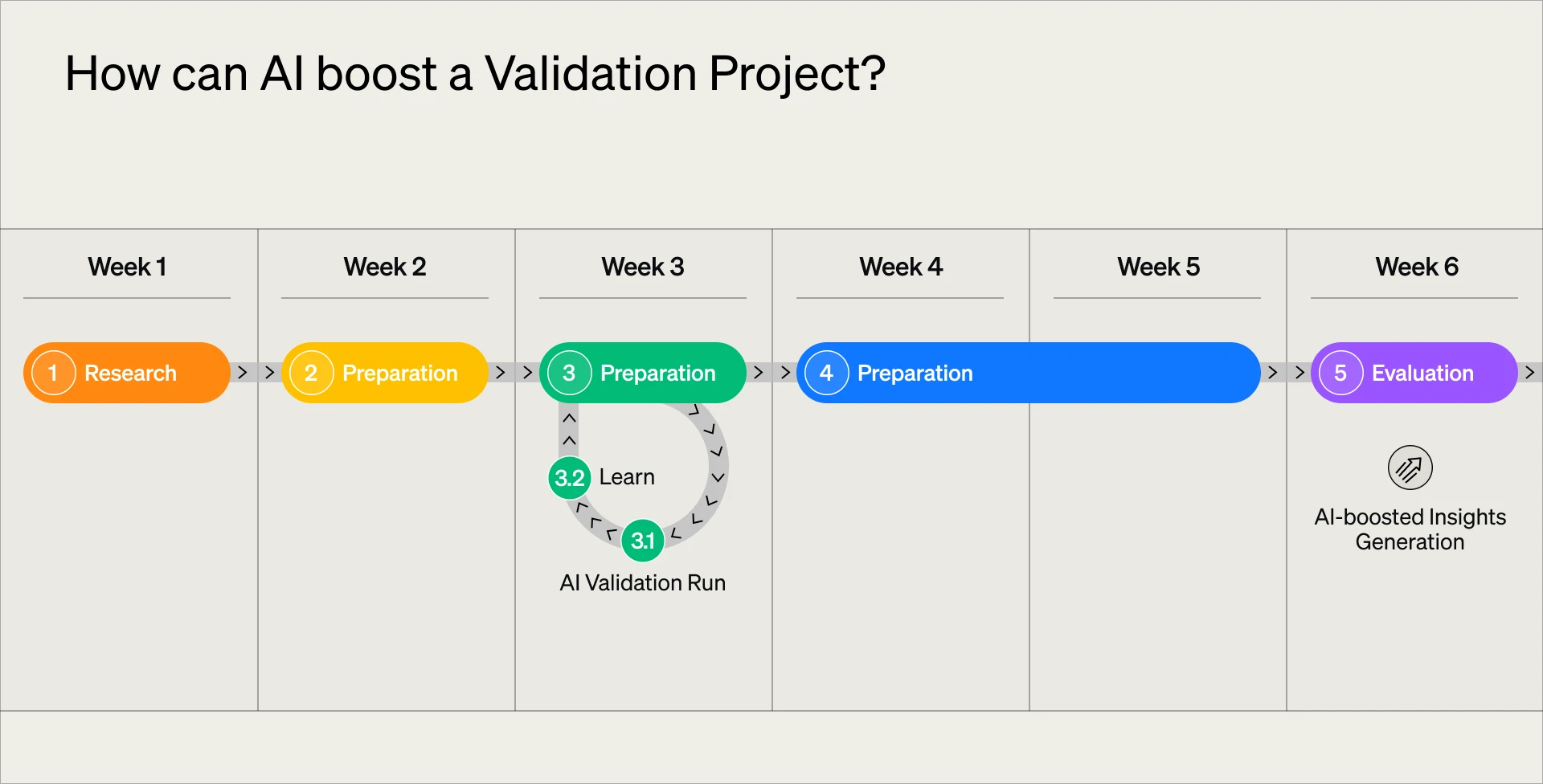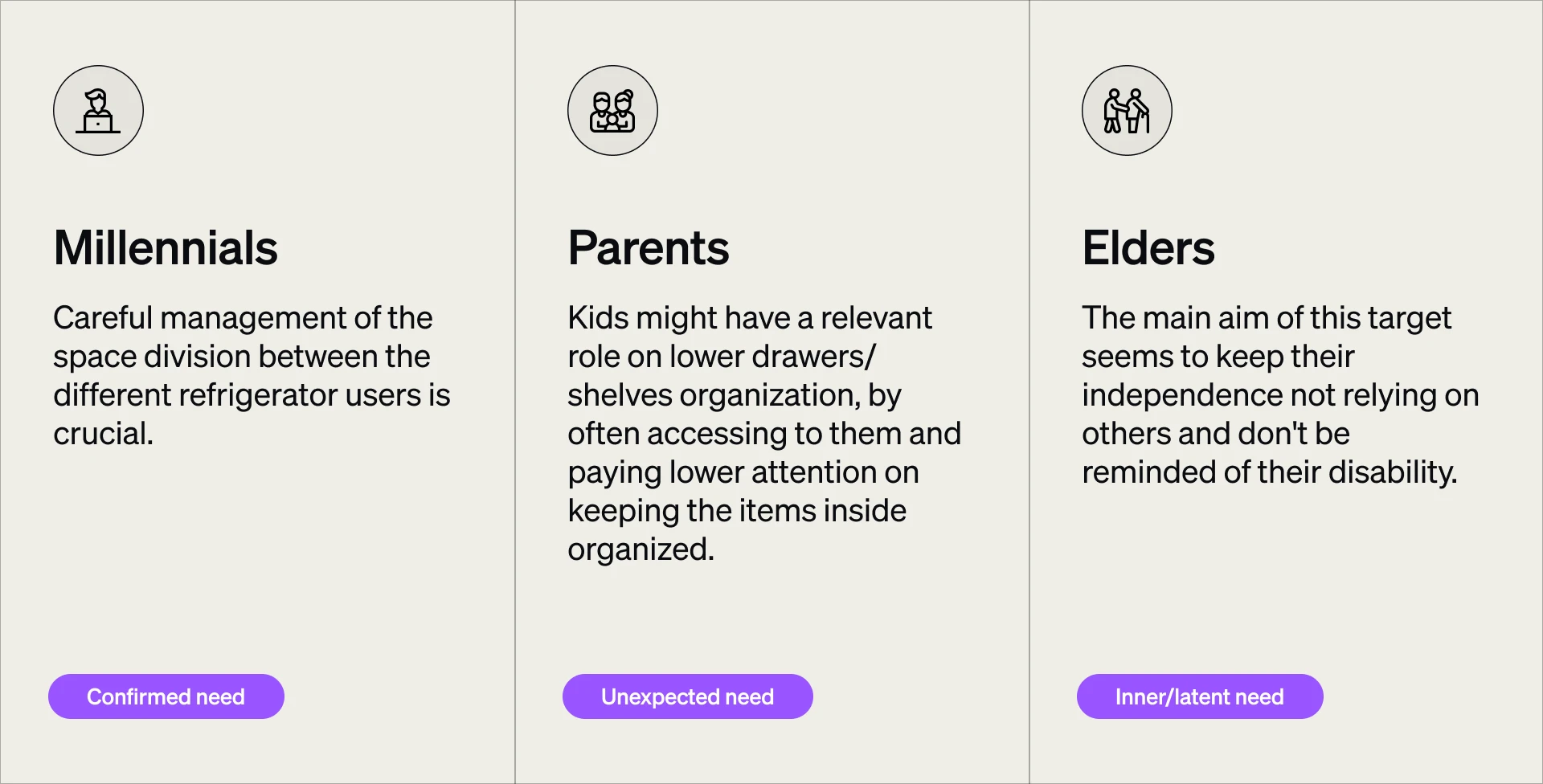Key takeaways
Last year, we all watched generative AI go mainstream, transforming how businesses operate, innovate, and deliver value to their customers. New tools are becoming available every day, boosting productivity and increasing revenue across almost every industry. In fact, according to McKinsey, Generative AI’s impact on productivity has the potential to add $2.6 to $4.4 T annually to the global economy. Here are just a few examples:
- Retail: 1.2 to 2.0% increased productivity, adding up to $660 B in annual revenue.
- Banking: 2.8 to 4.7% increased productivity, adding up to $340 B in annual revenue.
- Pharma: 2.6 to 4.5% increased productivity, adding up to $110 B in annual revenue.
The corporate innovation space is no exception, with a wide array of new AI-powered tools accelerating and enhancing validation cycles in product development—democratising the process and enabling quick, comprehensive experimentation across validation techniques.
To give you a better idea of how generative AI can boost user validation in innovation projects, let’s take a look at a real-world case study from a global kinematic systems provider. Specifically, we’ll be exploring how generative AI can be used in observational studies, qualitative interviews and surveys.

AI-Powered Validation Techniques
Before we get into the good stuff, let’s go over some of the details of the project:
- The client: A Global Kinematic Systems Provider
- What they do: Engineer and manufacture motion systems for the furniture, household appliance and mobility industries.
- The challenge: To detect user needs that will help OBE Kinematics optimise the ergonomics of the drawers located in the lower levels of refrigerators and freezers.
- Tools used: ChatGPT, Claude and Synthetic Users
We kicked off our data collection phase by dividing it into three steps:
Step 1. Observational Studies
Observational studies involve monitoring how users naturally interact with a product or service without intervention. It uncovers genuine user experiences and behaviours, offering insights into usability issues and satisfaction in real-world scenarios. It’s especially useful in identifying unreported challenges and improving product design based on actual usage patterns.
We used the technique to analyse how target users interacted with a variety of refrigerator configurations.
The AI hack:
We used ChatGPT, Claude and Synthetic Users to create and simulate synthetic personas. The approach allowed us to simulate real-life scenarios where these personas interacted with our products, mirroring potential user behaviours and reactions. The key here was not to replace traditional observational methods but to refine our approach by pre-testing the observational study's design and questions.
This enabled us to proactively identify areas that needed further clarification in our study protocols.
Step 2. Qualitative interviews
Qualitative interviews are in-depth conversations aimed at understanding user experiences, perceptions, and needs in relation to a product or service. The approach facilitates a deep dive into the why and how of user behaviours, offering rich, detailed insights that quantitative methods may miss.
We conducted these interviews to explore some of the different behaviours noted during the observational study phase.
The AI hack:
For our qualitative interviews, we used generative AI to create detailed personas and simulate interviews. This gave us an early idea of how real users might respond and helped us pinpoint which questions were clear and which ones needed to be simpler or more detailed.
In this scenario, generative AI tools like ChatGPT, Claude and Synthetic Users enabled us to test and refine our interview questions.
Step 3. Digital surveys
Digital surveys are structured online questionnaires used to collect feedback about a product or service from a wide audience. They’re a great tool for gathering data on user preferences, behaviours, and satisfaction levels.
We used digital surveys to collect quantitative data and some additional qualitative insights.
The AI hack:
For our digital surveys, we leveraged ChatGPT, Claude, and Synthetic Users to fine-tune our questions before they went live. However, attempting to simulate responses with these tools often yielded random results, missing the mark for insightful data (this was primarily due to the mostly quantitative nature of the surveys).
The real strength of Generative AI in this context was its assistance in crafting and structuring our initial set of questions. This enabled us to proactively adjust the wording, order, and structure of our survey questions, ensuring they were clear, engaging, and capable of eliciting the feedback we needed.
In each of the three steps described, generative AI tools gave us a sneak peek at how each persona might answer various questions, providing initial insights for refining our project design. This highlights how AI can facilitate rapid testing and experimentation, providing proactive insights that might have been unattainable without these AI-powered tools.
Generative AI in Data Analysis and Insight Generation
Now that we’ve covered the data collection part of our validation journey, let’s explore some of the ways generative AI can help you process data your data into actionable insights.
Tools used: ChatGPT, Otter.ai and Miro
Transcription and Synthesis
For this part of the validation process, we used AI tools to help us transcribe and analyse hours of audio and video recordings from our user interviews and observational studies. In most instances, the accuracy and efficiency of these tools were top-notch, but what really blew us away was the speed with which they were able to sift through complex data and identify key themes and patterns.
In other words, you can probably achieve the same results through traditional analysis, but it would be much more time and resource-intensive.
Turning Endless Data to Actionable Insights
Part of the appeal of generative AI lies in its ability to manage and analyse large volumes of data that would be daunting for any individual or even a small team. Think of it as a highly capable and efficient team member who can sift through hours of data, take notes and extract valuable insights, saving time and ensuring no key insights are overlooked.
Accelerating the Validation Process
With the help of our trusty AI tools, our team processed data from 15 observational studies (30 minutes each) and 15 Interviews (12 minutes each) in half the time. This efficiency gain gave us the time to focus on our results and how they would impact our project conclusions.

The Pros, Cons and Future Generative AI In User Validation
As we edge closer to a future where generative AI becomes a cornerstone in technology, its use in user validation processes will no doubt become even more important—with broad implications. To start, let’s explore some of the pros and cons.
The Pros:
- Increased Efficiency: Faster data collection and analysis, boosting productivity and accelerating results.
- Enhancing creativity: Freeing up researchers to focus on results and discover valuable insights.
- Streamlining Processes: Automating time-consuming tasks and facilitating rapid experimentation.
- Hyper-personalisation: Delivering tailored recommendations and content for individual users.
The Cons:
- Bias and Fairness: AI may amplify biases in data, affecting validation results.
- Ethical Concerns: The use of AI can pose ethical challenges around bias, privacy, misinformation and transparency.
- Overreliance: There's a risk of becoming too dependent on Gen AI tools, potentially overlooking the nuanced insights that human judgment can provide.
- Security Vulnerabilities: AI can be susceptible to adversarial attacks, compromising validation integrity.
Here are just some key ways Gen AI could shape user validation in the next few years:
- Enhanced Simulation and Modeling: Gen AI will drastically reduce development delays by enabling virtual testing of user behaviour.
- Predictive Analytics: Gen AI will get better at predicting user needs and market trends, guiding proactive innovation.
- Dynamic User Validation: User validation will become a continuous, interactive process with Gen AI, moving beyond static methods.
- Enhanced Prototyping: Rapid, realistic prototyping powered by Gen AI will speed up the innovation feedback loop.
- Integration of Diverse Data Sources: Gen AI tools will become more adept at merging varied data, facilitating a full view of user needs.
- Cost Efficiency: Gen AI will lower costs in user research and market testing, benefiting smaller businesses.
- Real-time Feedback: Gen AI tools will get better at gathering real-time user feedback, shortening development cycles even further.
Final thoughts
AI will continue to play a crucial role in enhancing the innovation journey, boosting productivity, accelerating results and fueling creativity at every stage of the innovation process. In other words, it's here to stay.
Some of the tools we used during our user validation process project included ChatGPT, Otter.ai, Claude and Synthetic Users. However, these are just the tip of the iceberg of what’s available. Here are some additional tools you might want to explore in your next user validation cycle:
- GPTs from OpenAi - Enables you to set up and combine multiple GPTs based on custom tasks like summarising long transcripts or generating insights.
- Miro Assist - Facilitates note gathering and mind mapping from interviews and sessions. You can also use Miro Assist to process your data and extract insights.
- fforward.ai - Allows you to analyse your customer interviews and synthesise the results into different insight themes.
If you're interested in learning more about generative AI and how it can help boost your corporate innovation strategy, get in touch. We’d love to hear from you!
—
Want to test a new concept or technology? Our validation support is powered by real customer data with tailored experiments designed for B2B, B2C or B2B2C venture concepts.








